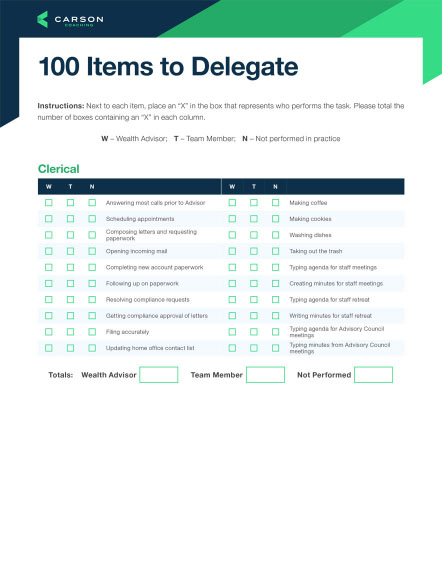How many of your clients work with other professionals – lawyers, insurance agents, realtors, bankers, etc.? The marketing-speak term for other professionals who hold sway in your clients’ lives is “centers of influence,” and those people can be a wealth of referrals if you approach them correctly.
As the Managing Director of Carson Wealth’s offices in Hagerstown, MD, and Kingsport, TN, my team has always had an interest in building genuine relationships with COIs in our community. After putting in some time building these relationships and fine-tuning our approach, now referral relationships with COIs are our sole source of new clients – and we’ve never asked for a single referral. Just last year, we signed a new $10 million client who sought us out just because I had taken his accountant out to lunch a couple times and invested in that relationship.
So how can you get a similar system in place for your firm? Here are the basic steps to get you started:
(Note: While I give all the steps here in this blog, if you’re looking for greater detail, I recommend watching my on-demand webinar on this subject here: 6 Steps to Building COI Relationships that Really Pay Off)
Step 1: Do Your Research
Before you can build relationships with your clients’ COIs, you have to know who they are. Find out who else your favorite clients work with – and don’t just limit it to obvious COIs like accountants, estate planning attorneys and bankers. If you specialize in working with retirees, seek out professionals in the area of geriatric care. Or if you specialize in working with business owners like I do, find out who they lease their office space from or who keeps the books for their business. Identify 12 high-value COIs and then schedule meetings with them.
Step 2: Meet Once per Quarter
At our firms, every team member is responsible for moving one growth metric per quarter. One person in particular has made it her business to keep me busy by booking a meeting with a different COI every week. So once a week, I’m sitting down to lunch, dinner or a phone call (which can work just as well as in person when necessary) with a different COI and checking in with them. With a list of 12 COIs, you should be able to meet with each one once per quarter. If you try to go beyond a core group of 12, it’s easy to end up overwhelmed.
Step 3: Set a Goal (but Not the One You’re Thinking)
Building professional relationships is great, but keep in mind you’re not just looking for a new friend here. For that reason, it’s important that you have a goal in mind for these meetings. And this is where a lot of people go astray and pick the wrong goal: “Get more leads.” Imagine if a COI called you to get together and then just asked you to give them leads. Maybe you’d send one or two their way, but would you ever agree to get together with them again? I doubt it. The goal here is to build lasting relationships that will result in a mutually beneficial exchange over the long haul.
Of course you want more leads, but every COI you schedule a meeting with is going to go into it expecting to be asked for leads. This is where you throw them a curveball by setting a better goal: to help the COI solve problems. Do whatever you can to position yourself as a problem-solver for every COI in your address book. What area of running a business do you consider yourself a specialist in? Hiring? Marketing? People management? Come armed with your best tips in that area. If they need help in another area, that doesn’t disqualify you, it just means you may need to do a little research (more on that in step 5). If you go into these meetings with the mindset of a problem-solver rather than a lead-hunter, you will truly set yourself apart.
Step 4: Ask the Right Questions
In order to find problems you can help solve, you have to ask the right questions. I have a list of questions I use every time I get together with a COI. Sure, it’s not rocket science, but having a list of questions you can check off helps you make sure you get to everything. Here are some of the most important questions I use:
- How’s business?
- What problems are your clients facing?
- What other professionals do your clients work with?
- Which professionals do you see as most effective? Why?
- Which do you see as least effective? Why?
Step 5: Go First
Once you find out which problem(s) they’re currently facing, figure out how you can help. Maybe send them an article that speaks to the issue or a video you think could be helpful. Avoid the temptation to just send them the first article you find in a Google search. While that would be easier, it may not be particularly helpful. The internet is full of articles that appear useful but are just a bunch of hot air.
And now comes the biggest part of all: go first in sending them a client referral. Think of a client who could benefit from the services this COI offers and make an introduction. Now you’ve proven that you know what you’re talking about and you will be a generous contact for them to know. That’s how you set yourself apart.
Step 6: Treat Them Better Than Your Top Clients
Most financial advisors have a hierarchy of gifts. You have your top clients who get the best and most frequent gifts, and then you have your other clients who get the standard gifts. If you want to build relationships with your COIs that really pay off, I propose that you create a tier even higher than your top clients. Look into hiring a gifting service to simplify the process (we use Giftology).
That’s it – six simple steps to forming professional relationships that could truly make a difference in the growth of your firm. Remember: go into this process with a generous spirit above all else. If you go in with your hands out, you’ll be sorely disappointed.


